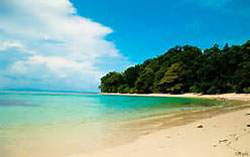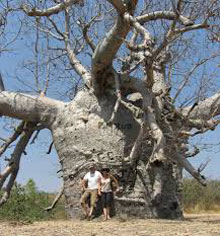September 2020 Environment
Sakshi Education
- Blue Flag international eco-label
 Eight Indian beaches have been recommended for the coveted ‘Blue Flag’ international eco-label.
Eight Indian beaches have been recommended for the coveted ‘Blue Flag’ international eco-label.
Blue Flag beaches are considered the cleanest beaches in the world.
The eight beaches are - Shivrajpur in Gujarat, Ghoghla in Daman and Diu, Kasarkod and Padubidri beaches in Karnataka, Kappad in Kerala, Rushikonda in Andhra Pradesh, Golden Beach in Odisha and Radhanagar beach in Andaman and Nicobar.
The announcement came on the eve of International Coastal Clean-Up Day, which is being celebrated with 100 countries since 1986.
- BEAMS (Beach Environment & Aesthetics Management Services)
India has its eco-label called "BEAMS" and is e-hoisting the flag simultaneously at these eight beaches.
Beach Environment & Aesthetics Management Services (BEAMS) has been launched by the Society of Integrated Coastal Management (SICOM, MoEFCC) under its Integrated Coastal Zone Management Project (ICZM).
It is one of the several other projects of ICZM that GoI is undertaking for the sustainable development of coastal regions striving for globally recognized and the coveted eco-label Blue Flag.
‘Blue Flag’ certification/tag
The ‘Blue Flag’ is a certification that can be obtained by a beach, marina, or sustainable boating tourism operator, and serves as an eco-label.
The certification is awarded by the Denmark-based non-profit Foundation for Environmental Education (FEE), which sets stringent environmental, educational, safety-related and access-related criteria that applicants must meet and maintain.
It is awarded annually to beaches and marinas in FEE member countries.
FEE's Blue Flag criteria include standards for quality, safety, environmental education and information, the provision of services and general environmental management criteria.
- Nandankanan Zoological Park: Odisha
Death of two sloth bears have been reported from the Nandankanan Zoological Park, Bhubaneswar (Odisha).
The exact cause of deaths is not yet known. Earlier, a 28-year-old Himalayan black bear died probably due to old age as bears are known to live for about 30 years.
Key Points
It is 15 kms from Odisha's capital, Bhubaneswar. It was inaugurated in 1960.
First zoo in the country to become a member of the World Association of Zoos & Aquariums (WAZA).
WAZA is the global alliance of regional associations, national federations, zoos and aquariums, dedicated to the care and conservation of animals and their habitats around the world.
It is recognized as a leading zoo for the breeding of the Indian pangolin and white tiger.
Leopards, mouse deer, lions, ratel and vultures are also bred here.
It was the world’s first captive crocodile breeding centre, where gharials were bred in captivity in 1980.
The State Botanical Garden of Nandankanan is one of the pioneering plant conservation and nature education centres of Odisha.
- African Elephant dying due to Cyanobacteria
Neuro-toxins in water produced by cyanobacteria killed more than 300 African elephants in the Okavango delta region, Botswana (country in Southern Africa).
Neuro-toxins are substances that damage, destroy, or impair the functioning of neural tissue.
Key Points
Cyanobacteria, also called blue-green algae, are microscopic organisms found naturally in soils and all types of water.
These single-celled organisms (bacteria) live in fresh, brackish (combined salt and freshwater), and marine water.
These organisms use sunlight to make their own food.
In warm, nutrient-rich (high in phosphorus and nitrogen) environments, cyanobacteria can multiply quickly.
Not all produce toxins but scientists say toxic ones are occurring more frequently as climate change drives up global temperatures.
Climate Change and Algal Bloom: An algal bloom is a rapid increase in the population of algae or cyanobacteria in an aquatic system.
- EPCA on Early Burning of Crop Residue
The Supreme Court-appointed Environment Pollution (Prevention and Control) Authority (EPCA) raised concerns about early burning of crop residue in Punjab and Haryana.
Key Findings
According to a SAFAR (System of Air Quality and Weather Forecasting and Research) under the Central government estimate which uses the INSAT-3, 3D and the National Aeronautics and Space Administration (NASA) satellite, the fire counts have increased from zero to 42 in a few days.
In 2019, about 9.8 million tonnes of the total estimated crop residue of 20 million tonnes were burnt in Punjab.
Similarly, in Haryana, of the total 7 million tonnes, 1.24 million tonnes of stubble were burnt.
- World Risk Index 2020
According to the World Risk Index (WRI) 2020, India is ‘poorly prepared’ to deal with ‘climate reality’, due to which it is vulnerable to extreme natural disasters.
Key Points
It is calculated on a country-by-country basis, through the multiplication of exposure and vulnerability and describes the disaster risk for various countries and regions.
Released annually since 2011, it indicates which countries are in the greatest need to strengthen measures for coping with and adapting to extreme natural events.
It is part of the World Risk Report 2020 released by the United Nations University Institute for Environment and Human Security (UNU-EHS), BundnisEntwicklungHilft and the University of Stuttgart in Germany.
Among continents, Oceania is at the highest risk, followed by Africa and the Americas.
- China’s Renewed Support for Paris Agreement
China has renewed its support for the Paris Agreement at the United Nations (UN) General Assembly, while calling for a ‘green focus’ as the world recovers from the Covid-19 crisis.
Key Points
China is the world's biggest polluter and accounts for a quarter of the planet's greenhouse gas (GHG) emissions.
It now aims to reach carbon-dioxide emissions peak before 2030 and achieve carbon neutrality before 2060.
The 2060 objective is still a decade later than the date set by other small states as well as European powers but it has been appreciated by experts as a significant step to inject momentum into the Paris accord.
In addition to its embrace of global emissions-busting deals, China already feeds nearly 15% of its energy demands with non-fossil fuels and its installation of renewable energy stands at 30% of the world total.
However, global experts have highlighted that there are massive investments continuing within China and overseas in coal and other fossil fuels.
China currently has 135 gigawatts of coal-power capacity either permitted or under construction, according to Global Energy Monitor, a San Francisco-based environmental group.
This equates to about half the total coal-power capacity in the USA which is the second-largest polluter after China.
- Net Present Value of Forests
 The Ministry of Mines has requested the Forest Advisory Committee (Ministry of Environment, Forest and Climate Change) to exempt digging exploratory boreholes from Net Present Value (NPV).
The Ministry of Mines has requested the Forest Advisory Committee (Ministry of Environment, Forest and Climate Change) to exempt digging exploratory boreholes from Net Present Value (NPV).
In 2018, the Ministry of Coal, the Ministry of Mines and the Ministry of Petroleum and Natural Gas had sought to be exempted from forest clearances for exploratory boreholes.
Key Points
An exploratory borehole is drilled for the purpose of identifying the characteristics, location, quantity and quality of a resource (coal, metal or petroleum).
It is a part of prospecting a site for future use for mining and extraction activities.
It is a mandatory one-time payment that a user has to make for diverting forestland for non-forest use, under the Forest (Conservation) Act, 1980.
This is calculated on the basis of the services and ecological value of the forests.
It depends on the location and nature of the forest and the type of industrial enterprise that will replace a particular parcel of forest.
These payments go to the Compensatory Afforestation Fund (CAF) and are used for afforestation and reforestation.
The CAF is managed by the Compensatory Afforestation Management and Planning Authority (CAMPA).
The Forest Advisory Committee constituted by the Ministry of Environment, Forest and Climate Change (MoEF&CC) decides on whether forests can be diverted for projects and the NPV to be charged.
It is a statutory body constituted by the Forest (Conservation) Act 1980.
Some projects have been provided exemption from paying NPV like construction of Schools, Hospitals, village tanks, laying down of optical fibre etc. Projects like underground mining and wind energy plants have been given a 50% exemption from NPV.
- Phytoplankton Biomass in Bay of Bengal
A team of scientists from the Indian National Centre for Ocean Information Services (INCOIS) have discovered a way to measure the quantity of chlorophyll-a that indicates abundance of phytoplanktons in the Bay of Bengal in real-time.
Key Points
Phytoplanktons are tiny microscopic floating plants found in water bodies.
Study of phytoplankton biomass is done by analyzing chlorophyll-a, a dominant pigment found in phytoplankton cells.
They contribute more than half of the oxygen in the environment.
They reduce global warming by absorbing human-induced carbon dioxide.
They also serve as the base of the ocean food chain.
They are important bioindicators regulating life in oceans. Their abundance determines the overall health of the ocean ecosystem.
- GoI launched National Clean Air Programme
Government of India (GoI) launched the National Clean Air Programme (NCAP) as a long-term, time-bound, national-level strategy. The programme aims to tackle the air pollution problem across the country in a comprehensive manner.
The target is to achieve a 20%-30% reduction in Particulate Matter concentrations by 2024 keeping 2017 as the base year for the comparison of concentration.
Highlights:
Based on the Air Quality data from 2014-2018, 122 non-attainment cities have been identified across the country under NCAP.
The city-specific action plans include measures to strengthen the monitoring network, reducing vehicular/industrial emissions, increasing public awareness, etc.
The programme will monitor the implementation of the city-specific action plans that are regularly monitored by Central and State level Committees namely the Steering Committee, Implementation Committee, and Monitoring Committee.
The air quality of cities is monitored by State Pollution Control Boards (SPCB) which publishes their results from time to time.
Also, for effective monitoring, few Smart Cities have established Integrated Command and Control Centres (ICCCs) which are connected to Air Quality Monitors (AQMs).
- Morphological Phenotypic Plasticity in Kalinga Frog
Indian scientists from the Zoological Survey of India, Pune have reported a first-of-its-kind discovery of morphological phenotypic plasticity (MPP) in the Kalinga cricket frog.
Key Points
Scientific Name: Fejervaryakalinga.
It is a recently identified species which was documented in 2018.
It was thought to be endemic only to the higher-elevation hill ranges of the Eastern Ghats in Odisha and Andhra Pradesh.
Cricket frogs are indicators of a healthy ecosystem and live in wide habitat ranges in agricultural fields, streams, swamps and wetlands.
Latest Findings:
It has been reported from the central Western Ghats, with the evidence of considerable MPP.
Its physical characteristics are entirely different from the other known Fejervaraya/Minervarya species from the Western Ghats.
Fejervarya is a genus of frogs in the family Dicroglossidae found in Asia.
Minervarya is a genus of frogs in the family Dicroglossidae.
It was the only genetic analysis that helped prove that physically different-looking frogs from eastern and western ghats were the same.
Morphological character utility (identification of structural features) is not enough to identify a species and its taxonomic (related to classification of organisms) uncertainties. Utility of genetic data and DNA barcoding tools help in resolving these.
- Reversing Global Wildlife Decline
Wildlife populations have fallen by more than two-thirds over the last 50 years, according to a Living Planet Report 2020 of the World Wildlife Fund.
Key Points
There has been a reduction of 68% in the global wildlife population between 1970 and 2016.
The highest biodiversity loss due to land use change: (1) Europe and Central Asia at 57.9 %; (2) North America at 52.5 %; (3) Latin America and Caribbean at 51.2 %; (4) Africa at 45.9 %; (5) Asia at 43%.
The sharpest declines have occurred throughout the world’s rivers and lakes, where freshwater wildlife has plummeted by 84% since 1970 — about 4% per year.
75% of the Earth’s ice-free land surface has already been significantly altered.
Most of the oceans are polluted.
More than 85% of the area of wetlands has been lost during 1970-2016.
- Wetlands Conservation
Rajasthan Government is acting proactively to protect the wetland ecosystem of the state with 52 wetlands earmarked for time-bound development.
In Rajasthan, Sambhar Lake and Keoladeo Ghana National Park have the prestigious tag of ‘Wetland of International Importance’, by the Ramsar Convention on Wetlands.
Key Points
Wetlands are defined as: "lands transitional between terrestrial and aquatic eco-systems where the water table is usually at or near the surface or the land is covered by shallow water".
Wetlands are highly productive ecosystems that provide the world with nearly two-thirds of its fish harvest.
Wetlands play an integral role in the ecology of the watershed. The combination of shallow water, high levels of nutrients is ideal for the development of organisms that form the base of the food web and feed many species of fish, amphibians, shellfish and insects.
Wetlands' microbes, plants and wildlife are part of global cycles for water, nitrogen and sulphur. Wetlands store carbon within their plant communities and soil (carbon sequestration) instead of releasing it to the atmosphere as carbon dioxide.
They provide habitat for animals and plants and many contain a wide diversity of life, supporting plants and animals that are found nowhere else.
They are also an important source of ground water recharge.
Wetlands are a vital source for food, raw materials, genetic resources for medicines, and hydropower.
Many wetlands are areas of natural beauty and promote tourism and many are important to Aboriginal people.
Also, they help in controlling the floods.
- African Baobab Tree has more chromosomes
 The journal Scientific Reports has found that the tree 'African Baobab' has 168 chromosomes. Previous studies estimated that the tree has between 96 and 166 chromosomes.
The journal Scientific Reports has found that the tree 'African Baobab' has 168 chromosomes. Previous studies estimated that the tree has between 96 and 166 chromosomes.
The study will be useful in genetic conservation efforts.
Key Points
The African baobab (Adansonia digitata) is one of the nine species of baobab and is native to mainland Africa. They are also found in African Savannah.
The African savannah ecosystem is tropical grassland with warm temperatures year-round and with its highest seasonal rainfall in the summer.
It is characterized by grasses and small or dispersed trees that do not form a closed canopy, allowing sunlight to reach the ground.
Oldest Known Angiosperm Tree: Carbon-14 dating places the age of a specimen of African baobab in Namibia at about 1,275 years.
As African baobab is a succulent, which means that during the rainy season it absorbs and stores water in its vast trunk, enabling it to produce a nutrient-dense fruit in the dry season when all around is dry and arid.
Baobab trees can live for more than a thousand years and provide food, livestock fodder, medicinal compounds, and raw materials.
Since 2005, 9 of the 13 oldest African baobab specimens and 5 of the 6 largest trees have died or suffered the collapse and death of their largest or oldest stems that may have been caused by the effects of climate change.
Published date : 10 Oct 2020 01:30PM


















